The September Consumer Price Index, which measures inflation, increased 0.3% from last month. Food increased 0.4% and energy 2.0%. Gas alone increased 2.9% in a month and food at home, or groceries, increased 0.6%. Core CPI, or price increases minus food and energy costs, rose 0.1%. Core CPI is a Federal Reserve inflation watch number. For the year, not seasonally adjusted, the Consumer Price Index for all Urban Consumers (CPI-U) has risen 3.9%. In August CPI also increased by 0.4%.

Core inflation stayed flat and also was it's lowest increase since March. Below is the monthly percentage change in CPI-U, all items. U stands for Urban consumers.
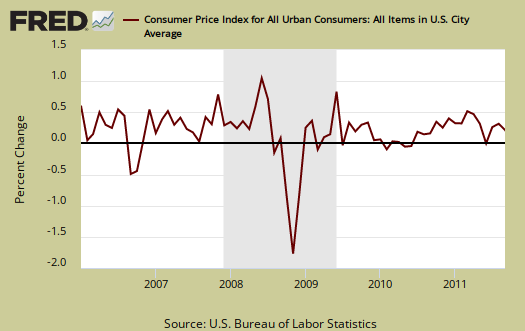
The core CPI, or all items less food and energy, percentage increase was 0.1% and the lowest since March. August core CPI was 0.2%. Shelter had it's lowest increase since April and is up 0.1%, with rent increasing 0.2% and home owners equivalent rent of primary residence increasing 0.1% but hotels, motels dropping -0.7%. Clothing dropped dramatically, -1.1% and used autos declined -0.6%. Medical care increased 0.2%.
Core CPI's monthly percentage change is graphed below. As we can see, overall, without energy and food, inflation abated in September.
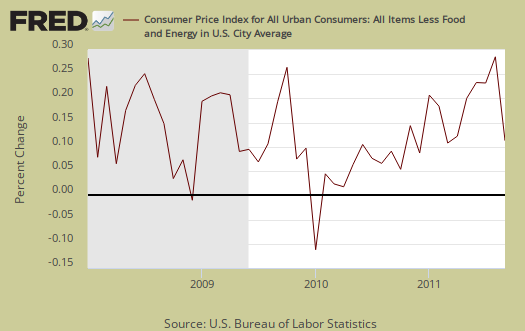
Below is the St. Louis FRED graph to show the overall index on core CPI, or CPI without food and energy included. We are seeing an acceleration uptick in core although the recession, which includes the last 2008-2009 portion of the graph was deflationary.
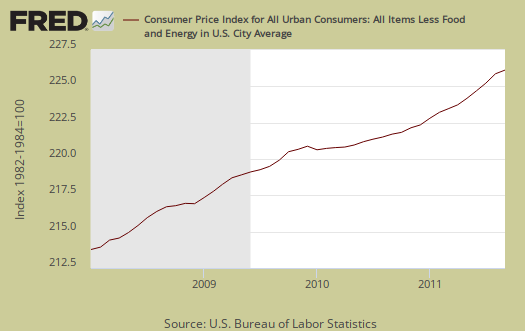
Food and beverages as well as groceries increased, 0.4% in September and the food index is up 4.5% for the year. Food at home, or groceries, increased 0.6% and is up 6.3% for the year. Dairy increased 1.2%, and is up 10.2% for the year. Fruits & Vegetables are up 6.7%, Meats, up 7.5% for the year.

Energy overall increased 2.0% and is up 19.3% for the year. Gas alone increased 2.9% for September and is up 33.3% for the year. Household energy increased 0.7%, but fuel oils for households, while declining -0.7% in September, are up 25.9% for the year. Below is the CPI-U Energy Index.
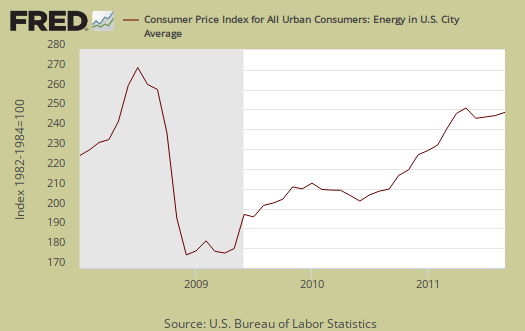
Below are gas prices, last updated October 17th. Notice the oil bubble in early 2008 and notice how close gas prices are now to that previous oil bubble. This CPI report only goes to September.
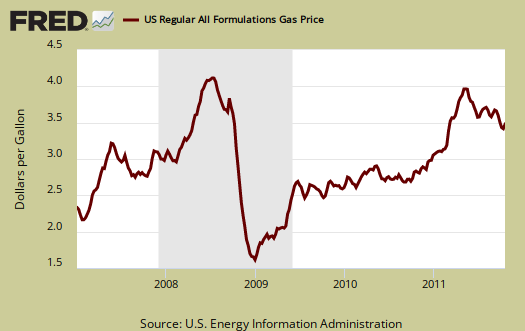
The CPI energy index, capturing the last oil bubble below, is all energy, gas, natural gas, fuel oil and so on. Notice it's dip and return versus the food index as well as how it's not as high as the CPI energy index was during the oil commodities bubble of 2008.

The Medical index increased 0.2% for the month and Medical care increased 0.2%, with services increasing 0.2%. Medical commodities are things like your prescription drugs and it increased 0.2% from last month. Strange isn't it, that Medical care is never mentioned when referring to costs and inflation. It's only as important as food, yet health care is treated almost like it's an extra for daily living. For the year, medical care is up 2.8%.
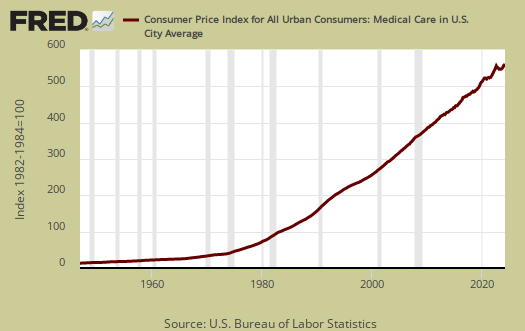
There has been much criticism as of late that the Federal Reserve only focuses in on core CPI, instead of food and energy. According to the BLS, Food and beverages, which includes food at home, makes up 14.8% of the index. Housing is 41.5% and transportation, including gas for the car, is 17.3%. Medical care is only 6.6%, they claim. All items minus food and energy are considered 77.2% of the total price expenditures for consumers.....according to them.
Regardless, this flattening in core CPI will probably keep the Federal Reserve doves (quantitative easing) talking.
The DOL/BLS does take yearly surveys on where the money goes in the monthly budget, but as one can see, food and energy are significant amounts of the monthly finances. Run away costs in these two areas can break the bank. Considering we have price deflation in housing due to the real estate sector bubble pop, it's strange for food and energy consumer prices to be dismissed when crafting monetary policy, dismissed as volatile. A year of data to me, isn't volatile enough to dismiss, especially when these are key critical needs for regular people.
CPI-W for the month, unadjusted was 223.688 , a +0.4% increase from last month and a 4.3% increase for the year. CPI-W is used to calculate government transfer payments, such as social security increases. We will estimate the social security increase in another post.
Note the the chained CPI-U also increased 0.1%, 0.1 % for the year and this is not seasonally adjusted. Chained CPI is in 2005 dollar values, which has a flattening effect on real inflation, thus flatting cost of living adjustments if used.
Last month's CPI report overview, unrevised, although most graphs are updated, is here.

SS increase announced
"CPI-W for the month, unadjusted was 223.688 , a +0.4% increase from last month and a 4.3% increase for the year. CPI-W is used to calculate government transfer payments, such as social security increases. We will estimate the social security increase in another post." -- Robert Oak
From AP story (19 October 2011) via Yahoo
COLA increase
I've got an injury preventing me from writing, so maybe, since the increase has been announced, I"ll let the calculation methods slide.
Bottom line, that's good for the economy and seniors although the deficit crazies are probably going nuts.
Inflation
CPI-U was up 3.87% from Sept. to Sept. (Federal Gov. Fiscal year). This is important when you look at the 2012 budget. The original budget was based on inflation being 1.3% for 2011. They increased the estimate to 2.8% in August when they released the Mid-Session Review. Despite the increase for 2011, they left the 2012 - 2021 values unchanged. They include values that average 2.0% and don't exceed 2.1%. Those values are extremely low considering historical trending, current FRB policy, basic economics and the size of our deficits.
Why is this important? Low values compound slower so they have understated the size of the deficits for the "out years" in the budget. Also using lower inflation assumption values allows them to use lower interest rate assumption values. (1% understatement of the rate we pay on our National Debt is equal to $200 billion understatement in Interest Outlays per year! There were 7 years with the National Debt over $20 trillion in the original budget.)
Playing with the numbers to make sure we don't understand how bad things really are?